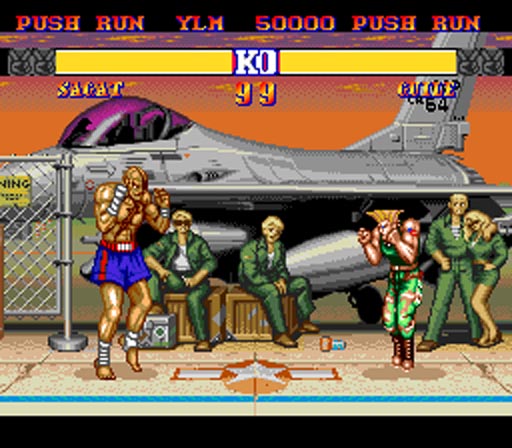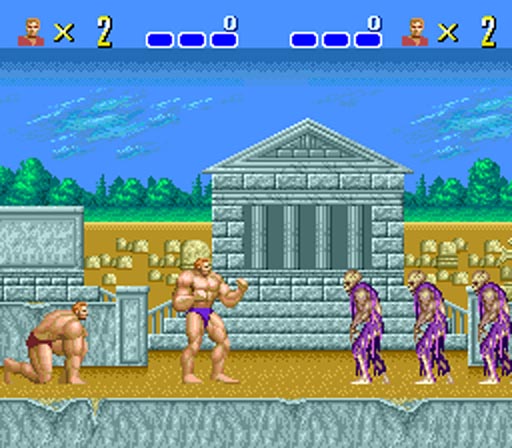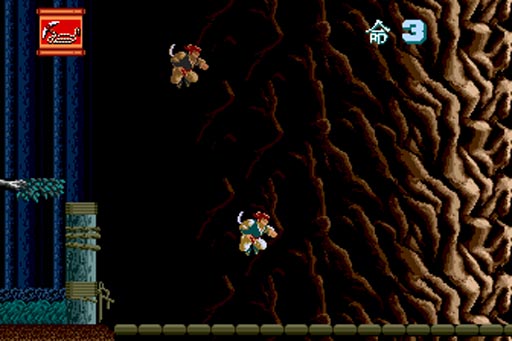TurboGrafx-16
| Lifespan: | 1989-1993 |
|---|---|
| CPU: | 7.16 MHz 8-bit HuC6280 4 |
| Audio: | 6 Channels (Uses CPU) 5 |
| Co-Processors: | 3.58 Mhz PSG 6 Video Processor: 16-bit HuC6270 7 Color Processor: HuC6260 8 |
| Resolutions: | 256x256 || 320x256 9 |
| RAM: | 8 KB |
| Video RAM: | 64 KB |
| Colors On Screen: | 480 (60-90 Average, ~128 Max in games) 10 |
| Color Palette: | 512 ( 32 Palettes of 16 colors each) 11 |
| Sprite Max & Size: | 64 at 16x16, 16x32, 16x64, 32x16, 32x32, and 32x64 pixels 12 |
| Sprites per Scanline: | 16 13 |
| Background Planes: | 1 Layer (Dynamic Tiles and Sprites were used to create up to four scrolling layers) |
| Storage: | HuCard 16Mbit (2.5MB), Average 4 Mbit CD-ROM |
Just as the battle between the 8-bit Nintendo Entertainment System and Sega Master System was looking one-sided the first of many electronics giants entered the fray. The NEC manufactured TurboGrafx-16 (TG16) was released in 1989 in the US and displayed impressive visual quality, audio and effects compared to its 8-bit predecessors and its 16-bit competition. NEC's game console boasts relatively high amounts of colors on screen at once, software scaling in games like Afterburner (Japan),14 and multi-level backgrounds (parallax) in space ship shooters. Despite the TurboGrafx's 8-bit central processor these effects demonstrate a significant edge in horsepower over the later released, fully 16-bit, Super Nintendo. The relative color limitation for Sega's Genesis should also lend NEC proper respect for designing a state of the art game console. As a result, game magazines in 1989 painted a picture of the TG16 quickly becoming a major contender in the US game console wars.15 16
The PC-Engine was released one year before the Megadrive (Sega Genesis) in Japan. By 1989 the PC-Engine, renamed TurboGrafx-16, had over one hundred software titles published and ready to be localized for the US market.17 Nintendo's monopoly, and subsequent restrictive licensing contract with third party developers, contributed greatly to hindering the localization of most of these software titles.18 As Nintendo's licensing contract for the NES is understood, no game made for the NES could be made for another console within two years. So, popular NES software such as the original Megaman, released December of 1987, could not be released on the TurboGrafx until 1990. Nintendo Entertainment System owners would meanwhile be playing the third iteration of Megaman. Game developers already had to decide whether to spend their time and money producing a game for an unproven console. For the initial years following their release, developers for the TG16 and Sega Genesis could only release arcade adaptations, new games or completely reprogrammed and rebranded versions of NES software.
Nintendo owned at least ninety percent of the game console and software sales in Japan and the United States in 1989, so NES software took priority for third party developers.19 This left the TurboGrafx with a relatively small selection of titles from NEC and Hudson Soft. Probably to compensate for bad press, NEC took a marketing stance of only releasing the "best of the best" PC-Engine titles locally. Nevertheless, the final TG16 library pales in comparison to what was available for the PC-Engine in Japan.20 It is no coincidence that many of the games that were never localized were superior versions of popular NES software. The opinion, however, of journalist created history claims that what few PC-Engine titles were localized by NEC, Hudson, and a handful of third parties were not "fun," or popular enough, to make the console successful in the United States.21 22
 Sega and Nintendo managed to publish and license enough games during the previous generation's formative years to be roughly equal in library by the end of 1989. During these years, Nintendo spent more time courting developers than making games. As a result, from 1990 to 1992, no console could compete with the flood of software releases on the NES.23 So non-Nintendo hardware should be viewed as a separate market during this time. In 1989 and 1990 the TG16 saw roughly the same amount of quality software releases as the Sega Genesis and Master System combined.24
Sega and Nintendo managed to publish and license enough games during the previous generation's formative years to be roughly equal in library by the end of 1989. During these years, Nintendo spent more time courting developers than making games. As a result, from 1990 to 1992, no console could compete with the flood of software releases on the NES.23 So non-Nintendo hardware should be viewed as a separate market during this time. In 1989 and 1990 the TG16 saw roughly the same amount of quality software releases as the Sega Genesis and Master System combined.24
NEC also took the cutting edge title in 1990 by releasing the CD-ROM add-on for the TurboGrafx. The Turbo CD added an additional library of over one hundred CD-ROM titles, including excellent Role Playing Games (RPGs). NEC promised an affordable price for their CD-ROM add-on, but the list price for the Turbo CD ended up being $399. Much the same as Sega's Master System, NEC's add-on was relatively difficult to find on store shelves. Insufficient localization effort for the add-on's pre-released Japanese library is another oft cited flaw of NEC's marketing strategy. So select, according to popular game magazines, was the Turbo CD localizations that the game media accuses NEC for single handedly killing the add-on.
The TurboGrafx and the Turbo CD-ROM were left with fewer titles, by a ratio of at least 7:1, in comparison to the Sega Genesis alone by the end of the 16-bit generation. In 1989 and 1990, however, the TG16 saw roughly the same amount of quality software releases as the Sega Genesis and Master System combined.25 By Spring of 1991 the TurboGrafx library had grown to the point that the main thrust of NEC's advertising campaign stated "It's easy to beat the competition when you've got them outnumbered."26 It was in fact only after the Super Nintendo and Sega CD were on the market in 1992 that the TG16's library dramatically lagged in software releases of notable quality.
According to inconsistent online sources, the TurboGrafx-16 only sold around 2.5 Million units in the US by 1993, a significant failure when compared to Sega's Genesis that sold over 20 Million in the US by 1995. The TG16's marketability effectively began and ended in 1990 when the Genesis proved to be the relative marketing success and Sega devoted all of its resources to toppling Nintendo's gaming empire. Yet the TG16-CD combination saw one more significant push in 1992, when Turbo Technologies Inc (TTI) launched the Turbo DUO. The tale of TTI's two systems in one will be discussed in greater detail in its own section.
- 1. Jonathan J. Burtenshaw, ClassicGaming.com's Museum NEC TurboGrafx-16 (TG16) - 1989-1993 (archive.org February 1, 2008)
- 2. TurboGrafx-16/Duo FAQ - By John Yu, Last revised: 05/25/95 (archive.org May 14, 2007)
- 3. emulationzone.org Turbo-Grafx/PC-Engine Emulation Sections (archive.org June 15, 2008)
- 4. GAMESX.com Forums, Console Mods, RobIvy64 (e-mail) "TG-16/PCE overclocking success!" (archive.org May 1, 2008)
- 5. 6 Waveforms, 1 Frequency Modulated Channel leaves 4 Waveforms, 1 Waveform Channel can become White Noise, all channels can be programmed for sound samples. Paul Clifford (e-mail), PC Engine Programmable Sound Generator (psg.txt) (accessed February 18, 2010) available from http://www.plasma.demon.co.uk/pcengine/; internet.
- 6. Clifford, psg.txt $0802 - Fine frequency adjust
- 7. Emanuel Schleussinger, PC-Engine Video Display Controller Documentation (vdcdox.txt), (February 1998, accessed March 19, 2010) available from http://www.zophar.net/documents/pce.html; internet.
- 8. Paul Clifford (e-mail), PC Engine Video Colour Encoder (vce.txt)(accessed February 18, 2010) available from http://www.plasma.demon.co.uk/pcengine/; internet.
- 9. Typically only 216 horizontal lines are visible and are either 256 or 320 pixels wide, Schleussinger, (vdcdox.txt) 5. The Sprites in the VRAM.
- 10. Sixteen 15 Color palettes for the background, sixteen 15 Color Palettes for Sprites, Clifford, (vce.txt).
- 11. Clifford, (vce.txt).
- 12. Nimai Malle (e-mail), pce_doc Video Sprites (accessed March 20, 2010) available from http://emudocs.org/?page=PC%20Engine
- 13. Actual limit may be 8 due to 16 pixel wide sprites being aligned as 32 pixel sprites, Malle, pce_doc Video Sprites
- 14. Scaling is the technical term for a two dimensional object that moves closer or further away from the screen in an animated sequence. The term does not included animated sprite transitions to simulate the same effect.
- 15. "16-bit Sizzler," Electronic Gaming Monthly, May 1989, 30.
- 16. Steve Massey, "The Cutting Edge: The TurboGrafx-16," Gamepro, July 1989, 11.
- 17. Steve Harris, "Turbo to Increase Library of Titles," Electronic Gaming Monthly, December 1989, 50.
- 18. David Sheff, Game Over: How Nintendo Zapped an American Industry, Captured Your Dollars, and Enslaved Your Children (New York: Random House, 1993), 215.
- 19. Steven L. Kent, The Ultimate History of Video Games (New York: Three Rivers Press, 2001), 423.
- 20. "Slasher Quan," "So, You Want to Buy A 16-Bit System...", Gamepro's 16BIT Video Gaming, February 1992, 7.
- 21. Sheff, Game Over, 351.
- 22. Kent, The Ultimate History of Video Games, 449-450.
- 23. Tom R. Halfhill, "Software Shakeout," Game Players, January 1991, 4.
- 24. Notable Games: 1989-1990, http://www.gamepilgrimage.com.
- 25. Notable Games: 1989-1990, http://www.gamepilgrimage.com.
- 26. Electronic Gaming Monthly, March 1991, 28-29.
- Printer-friendly version
- 22664 reads

